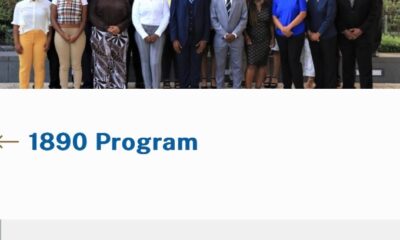Featured
The Coronavirus Challenge to Voting

It was a happy St. Patrick’s Day for former Vice President Joe Biden. On March 17th in primaries in Arizona, Florida and Illinois, he won it all.
In 19 days, Biden cemented his position as the presumptive Democratic presidential nominee. Thanks in large part to his support among Black voters, Florida joined a growing list of states, including South Carolina, Michigan, Mississippi and Missouri, in which Biden won every single county.
The margins of victory were impressive. In Florida, Biden led by almost 40 percent of the vote, winning 74 percent of the Black vote. The frontrunner triumphed in Illinois by 23 percent of the vote with 67 percent of the African American vote. Arizona was the closest contest, 43.4 percent to 31.5 percent and has the smallest Black population among the three states. Among the 27 percent Latinx population in Arizona, Biden squeaked out a win over Vermont Senator Bernie Sanders, 45 percent to 44 percent.
After polls closed, 295 delegates separated the two-man presidential race. Biden breezed past 1,000 delegates to reach a new total of 1180, compared to 885 for Sanders.
A little more than 40 percent of the delegates are still outstanding with many primary dates uncertain. Up until the last minute, Ohio expected to vote on Super Tuesday III. The state’s primary day was on and off again due to the coronavirus.
On March 16th, a judge ruled that Republican Governor Mike DeWine could not delay voting. Hours later, DeWine’s Health Director Dr. Amy Acton ordered the change anyway. Ohioans now go to the polls on June 2nd.
Six other governors in Georgia, Kentucky, Louisiana, Maryland, Puerto Rico and Wyoming have delayed voting. New York is considering postponing the primary, scheduled for April 28th. The global pandemic is the rational for the new dates.
The life or death threat of the virus is a real challenge for voting. Where do you move polls from senior centers? How do you protect voters and poll workers? The list of problems to be solved is daunting.
In a recent letter, 200 civil rights groups urged alternatives to in-person voting, not delays of primary days. Tom Perez, chairman of the Democratic National Committee, echoed this sentiment. He would like states to implement other options to in-person voting, such as vote by mail, absentee ballot with curbside drop offs and early voting. Ohio has extended its early voting from now until June 2nd. On the other hand, as part of moving Georgia’s primary day from March 24th to May 19th, the state stopped early voting which began on March 2nd.
The uncertainty in the primary schedule due to the virus is one more reason to end the Democratic primary, according to some from House Majority Whip James Clyburn to former Obama advisor David Axelrod. In addition to practically an insurmountable lead in the delegate race, Sanders cannot campaign in the usual way – no rallies and no door-to-door canvasses.
Sanders may agree with Clyburn and Axelrod. His campaign manager Faiz Shakir issued a statement, saying “Sen. Sanders is going to be having conversations with supporters to assess his campaign.” The Vermont Senator has not publicly reacted to his Super Tuesday III thumping. But Biden has.
Sporting a green tie in front of two flags, the frontrunner addressed the nation. He talked more about how “tackling the global pandemic is akin to fighting a war” than flattening Vermont Senator Bernie Sanders.
Biden recognized the contributions of Sanders and his supporters to the national dialogue around affordable healthcare, income inequity and climate change. He spoke directly to this audience by saying,
“Senator Sanders and his supporters have brought a remarkable passion and tenacity to all of these issues and together they have shifted the fundamental conversation in this country. So let me say, especially to the young voters who have been inspired by Senator Sanders, I hear you, I know what’s at stake. I know what we have to do. Our goal as a campaign and my goal as a candidate for president is to unify this party and then to unify the nation. You know, it’s in moments like these we realize we need to put politics aside and work together as Americans.”
Singling out young voters is a smart move. Sanders consistently has more support among Gen Z, Millennials and early Gen X voters than Biden. Take Arizona where 28 percent of voters are 18 to 44 years old. Sanders received 52 percent of these votes. There are similar majorities of young voters in Florida (Sanders, 52 percent to 39 percent) and Illinois (Sanders, 66 percent to 29 percent).
In a statement, Sanders’ campaign noted that the candidate may have three weeks until the next primary to assess his campaign. Almost 60 percent of the nation’s voters have given the candidate their feedback which is reflected in the delegate count.
Whether Sanders drops out or stays longer is ultimately a voter decision. With 26 states and 1339 delegates at stake in the remaining contests, voters need to do their homework before heading to the polls. When is my primary day? Do I have new options on how I vote, such as a longer period to vote early or by mail or absentee ballot? If my polling place is in a senior center, do I have a new location?
Let’s get to work. Keep pushing the vote!
Holli L. Holliday is a practicing attorney and president of Sisters Lead Sisters Vote, a nonprofit c4 organization for, by and of black women.

-

 Featured10 months ago
Featured10 months agoCalifornia Is the First State to Create A Public Alert for Missing Black Youth
-

 Featured9 months ago
Featured9 months agoAfrican American Leaders Stay the Course Amid Calls for President Biden To Bow Out of Race
-

 Featured10 months ago
Featured10 months agoThe Debate Fallout Lands on Both Candidates
-

 Featured9 months ago
Featured9 months agoPresident Joe Biden Decides to Withdraw from the Presidential Race
-

 Featured9 months ago
Featured9 months agoIn One of His Final Speeches as President, Biden Says It’s Time for ‘Fresh Voices’
-

 Featured9 months ago
Featured9 months agoPresident Joe Biden Describes Shooting of Donald Trump As ‘Sick’









